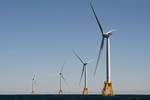Gazelle Wind Power offshore wind platform design principles confirmed
Basin model tests verify feasibility of floating offshore wind platform’s use in a wide range of conditions.
An artist’s impression of the floating offshore wind turbine solution. Photo Credit: Gazelle Wind Power
Gazelle Wind Power (Dublin, Ireland), the developer of a hybrid modular floating offshore wind platform, has received the results of its basin model tests at the Environmental Hydraulics Institute – University of Cantabria (IHCantabria) facilities in Spain. The test report, witnessed by international certification organization DNV (Oslo, Norway) and Safier Ingenierie (Serris, France), verified the feasibility of the Gazelle platform’s concept in a wide range of conditions. A prototype model of Gazelle’s platform was analyzed through a variety of assessments including surge and yaw excitation tests, wind alone tests, wave alone tests, decay tests and more.
“The test serves to further validate our technology — which is key to ultimately reaching commercialization and unlocking the full potential of offshore wind,” Gazelle CTO Jason Wormald says. “These tests show that our platform will serve as a vital piece of the energy transition that will center around decarbonization, independence and security.”
The main results from the tests were based on the 10-megawatt (MW) floating offshore wind turbine (FOWT). The tests reportedly confirmed Gazelle’s main principles — including the main physical principles behind the platform design. The tests also reaffirmed that the Gazelle platform has significantly reduced pitch motions even in extreme sea conditions. The data collected from the various tests will be used to create a benchmarking database which will be the basis of the next phase of the design loop in conjunction with Safier Ingenierie.
Having recently named Wormald to lead Gazelle’s technology and engineering teams, Gazelle says it has now taken a critical leap forward toward deploying its offshore floating wind platform that — through modularity, scalability and the ability to be mass produced — can unlock opportunities in the floating offshore wind market, which has a total addressable market worth approximately €750 billion by 2050, according to DNV.
See “Gazelle Wind Power teams up with Ferrofab for hybrid floating wind platform.”
Related Content
-
JEC World 2023 highlights: Recyclable resins, renewable energy solutions, award-winning automotive
CW technical editor Hannah Mason recaps some of the technology on display at JEC World, including natural, bio-based or recyclable materials solutions, innovative automotive and renewable energy components and more.
-
NCC reaches milestone in composite cryogenic hydrogen program
The National Composites Centre is testing composite cryogenic storage tank demonstrators with increasing complexity, to support U.K. transition to the hydrogen economy.
-
Polar Technology develops innovative solutions for hydrogen storage
Conformable “Hydrogen in a Box” prototype for compressed gas storage has been tested to 350 and 700 bar, liquid hydrogen storage is being evaluated.

















